Galleys! |
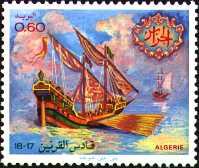
|
Galleys were long, narrow and nimble rowed warships with auxiliary sails.
Their low profiles, short breadths and shallow drafts limited their stability
and seaworthiness.
The earliest galleys were built during the twelth century B.C., with one bank
of oars, one mast and a square sail. The last sea battle among galleys
occurred in the 18th century.
|
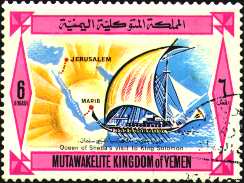
|
The first galleys were those of the Phoenicians, representing the most
powerful warships in the Mediterranean for some six hundred years. Around 700
B.C. biremes appeared on the seas; two hundred years later the Greeks
introduced triremes, with three banks of oars. All were fitted with ram-bows
to penetrate the hull of an enemy ship, and solid armoured bulwarks to
protect the oarsmen from arrows and spears.
|
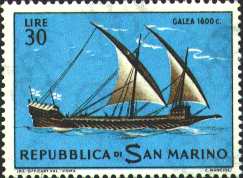
|
By the 12th century A.D. one or two masted galleys with lateen sails were the
'dreadnoughts' of the city republics of Venice, Genoa, and Amalfi. Here the
designation 'galley' was born, the ship's ram-bow being likened to the
swordfish 'galeos' with its head and sword. The ships were 40 to 50 meters
long and 5 to 8 meters wide, with some two meters draft. They reached speeds
of up to 12 knots with favorable winds from astern.
|
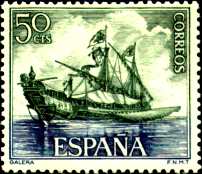
|
The majority of galleys used to have two rows of oars on each side; then
during the 14th and 15th centuries most used just one bank of oars. Each oar
was pulled by three men, or even five on the largest ships, with oars up to
12 meters long. Average speeds were 3-4 knots normally; reaching up to 7-8
knots during combat. Originally rowed by free seamen, soon it became
customary to use the forced labor of prisoners and slaves. The slaves'
inhuman treatment led to the galley's reputation as the most infamous type of
vessel afloat.
|
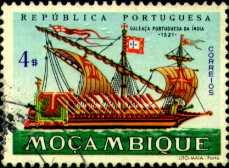
|
Sea battles were close-in affairs with hand-to-hand combat. Galleys would
enable their warriors, often 300 to 500 strong, to board enemy vessels the
moment their ram-bow barreled into the foe's hull. Since Phoenician times
these rams were designed to snap off after impact, thus leaving the attacker
free and still watertight. Armaments consisted of a powerful bow gun, smaller
cannons and catapults wreaking havoc on the enemy at shortest distance.
|
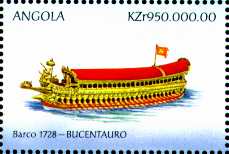
|
By mid-ninth century the city of Venice had become one of the most important
of the Mediterranean maritime powers. To affirm its dependence on the sea and
its maritime interests a ceremony was instituted whereby the state galley
'Bucentauro' was rowed out to sea each Ascension Day and the Doge, leader of
the republic, symbolically married the city to the sea by throwing a golden
ring into the waters. The stamp on the left shows the state galley.
|
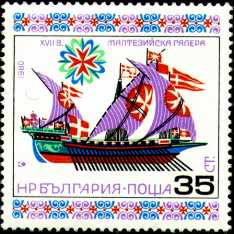
|
In 1530 Emperor Charles V bestowed the island of Malta to the Knights of the
Order of St. John, entrusted with a mission to fight all 'infidels',
especially the Turks. The order built up a large fleet of galleys and several
galleasses. Bow and stern of their vessels showed richly carved
ornamentation, hulls sported the order's colors, and the sails displayed
colorful Maltese crosses. But below decks it looked differently: criminals
and Turkish prisoners-of-war were chained to their oars under the most
inhumane conditions. With the Pope's blessings each vessel carried aboard a
sacred oblate; in deference ships from other Christian nations gave them the
'right of way'. The galley shown on the stamp is the 'Capitana' of a Grand
Master around the year 1600.
|
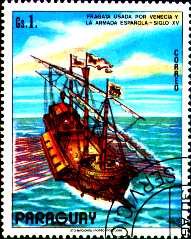
|
The galeass was a rather large version of a galley, also called 'galea
grossa'. They appeared early in the 16th century, with lengths of 50, later
70 to 80 meters, and breadths up to 16 meters, rigged with several masts with
lateen sails. Extremely long oars were pulled by 4 to 7 rowers. There were
up to 70 guns in gun ports capable of firing in any direction. Total crew
compement amounted to some 800 rowers, sailors, and soldiers. Their
seaworthiness was vastly superior to the galleys, capable of navigation
during the winter season.
|
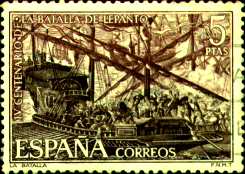
|
The stamps to the left and right depict the greatest galley battle ever
fought, the famous Battle of Lepanto, off the Greek coast, in1571. The fleet
of the Holy League, organized by most of Christian Europe-principally Spain,
Venice, Malta and the Holy See-under the command of 25-year old Don Juan of
Austria, defeated the Turks led by Admiral Ali Pascha. The Allied Fleet
consisted of 200 galleys and 6 galleasses, with a further 100 ships (unknown
to the Turks) without oars in the rear, and a complement of some 80,000
sailors, rowers, and soldiers. The Turks numbered some 274 galleys and
galliots with altogether 88,000 men. A bloody massacre ensued when both sides
engaged each other. Galley was locked to galley, oars splintered, guns
discharged at point-blank range, and warriors boarded their enemy in fierce
hand-to-hand combat.
|
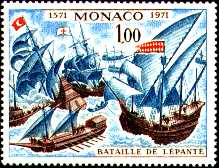
|
In the end, the outcome was decided by the League's six giant galleasses and
the 100 ships in the rearguard reserves. Both sides suffered huge casualties
in the carnage. Although the League lost but 13 galleys, there were 7,600
dead and just as many wounded. The Turks counted over 200 of their ships sunk
or beached, with more than 30,000 dead-among them many rowers chained to
their banks who perished with their vessels. A triumph for the League was the
liberation of close to 15,000 Christian galley slaves from the vanquished
Turkish fleet. Many historians claim that this victory preserved Europe for
Christendom.
|
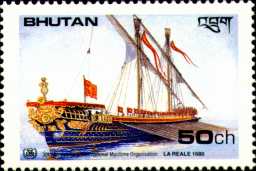
|
After the Battle of Lepanto the galley's role as man-of-war lost its
importance. Yet, during the reign of Louis XIV (1643-1715) France continued
to build a number of extravagantly appointed galleys-mainly to provide
traditional platforms for naval officers from prominent aristocratic
families. Galleys remained in the French Navy until 1749. The galley shown
on the stamp named 'La Reale' of 1680 represents a ship of the French Royal
Navy-not a real name but the designation of all flag ships of the French
fleet at the time (and not to be confused with Juan of Austria's earlier
'Reale' of the Battle of Lepanto).
|
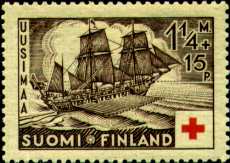
|
As evidenced by these two stamps, there were galleys even in the Baltic,
where Swedes and Russians confronted each other. These long, slim craft with
shallow draft were ideally suited for navigation around the rugged coastal
fjords. Czar Peter the Great was the first to have galleys built 'the Turkish
way' in 1704; Sweden followed in 1712. Starting in 1760 at a shipyard in
Stockholm the 'Uusimaa' type shown on the stamp made its appearance, 37 m
long, 9 m wide, with 2.5 m draft. There were 20 pairs of oars on each side
aided by square rigged sails, 15 guns, and a crew of 120 men.
|
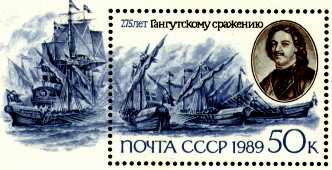
|
This Russian souvenir sheet commemorates the 275th anniversary of the Battle
of Hängö off the Finnish coast, in 1714. Swedes and Russians met in combat in
this first galley battle of the Baltic Sea which resulted in victory for
Russia. In the upper right we see Czar Peter the Great, called the 'Father of
the Imperial Russian Navy'.
|
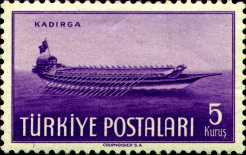
|
The Turkish stamp depicts the galley 'Kadirga', a 15th century relic, and the
only surviving galley in the world. For the exhibit in Istanbul's Naval
Museum the masts had to be removed. Technical data: Length 37 m, breadth 6
m,draft 2 m, displacement 140 tons, 24 oars, each one rowed by three men.
|
to the beginning!
back to the menu!
next page: ships of the line!
|













